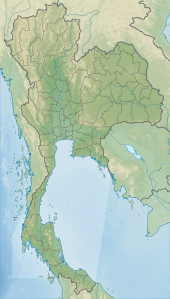| Sai Yok National Park | |
|---|---|
| อุทยานแห่งชาติไทรโยค | |
IUCN category II (
national park) | |
 Khwae Noi river in Sai Yok National Park | |
| Location | Kanchanaburi Province, Thailand |
| Nearest city | Kanchanaburi |
| Coordinates | 14°25′4″N 98°44′50″E / 14.41778°N 98.74722°E |
| Area | 500 km2 (190 sq mi) |
| Established | October 1980 |
| Visitors | 117,401 (in 2019) |
| Governing body | Department of National Parks, Wildlife and Plant Conservation |
Sai Yok National Park ( Thai: อุทยานแห่งชาติไทรโยค) is a national park in Sai Yok district, Kanchanaburi Province, Thailand. The park, home to mountains, waterfalls and caves, is part of the Western Forest Complex protected area.
Geography
Sai Yok National Park is in the Tenasserim Hills mountain chain, 100 kilometres (62 mi) northwest of Kanchanaburi town. The park's area is 312,500 rai ~ 500 square kilometres (190 sq mi). [1] The Khwae Noi river ("River Kwai") runs through the park. The park's highest peak is Khao Khwae at 1,327 metres (4,354 ft). The western boundary of the park adjoins Myanmar. [2]
Climate
Temperatures in the park area have a wide annual range from 8 °C (46 °F) to 45 °C (113 °F). The driest time of the year here is from December to February, while the rainiest time is from May to October. [3] [4]
History
Within the park are remains of a bridge on the Burma Railway and of a camp used by Japanese troops during World War II. [2] [5]
In 1978, the Russian roulette scenes of the film The Deer Hunter were filmed in the park. [3] On 27 October 1980, Sai Yok became Thailand's 11th national park. [4]
Attractions

The park's major attractions are its waterfalls, including Sai Yok Yai waterfall which flows into the Khwae Noi river. Sai Yok Yai Lek waterfall lies south of Sai Yok Yai along the Khwae Noi. [2]
The park also contains numerous caves, the largest of which is Tham Lawa with a length of 500 metres (1,600 ft). This cave complex consists of five large caverns, each containing large stalactites and stalagmites. [3] Another cave system, Tham Daowadueng, is 100 metres (330 ft) long and was discovered in 1972. Tham Daowadung consists of eight chambers of stalactites and stalagmites. [2]
Flora and fauna
Sai Yok's forest is primarily teak forest. During the Japanese occupation of Thailand, teak trees were felled for use as railway sleepers on the Burma Railway. The teak forest was replanted in 1954. [6] Other tree species include Shorea obtusa, Xylia xylocarpa, Bambusa bambos, Walsura robusta and Dialium cochinchinense. [2]
Animal species include elephants, tiger, barking deer, sambar deer, wild pig, gibbon, Malayan porcupine, slow loris and serow. [3] [4] A species of crab—the Rachinee crab, coloured red, white and blue—was discovered in the park in 1983. [3] [5]
Sai Yok is home to Kitti's hog-nosed bat, a rare bat species considered to be the world's smallest mammal (weighing around 2 grams). The bat was first spotted in 1973 and is found only in some limestone caves of the park (including Tham Kang Kao) and surrounding areas in Kanchanaburi Province and nearby Myanmar. [3] [4] [5] [7]
See also
References
-
^
"ข้อมูลพื้นที่อุทยานแห่งชาติ ที่ประกาศในราชกิจจานุบกษา 133 แห่ง" [National Park Area Information published in the 133 Government Gazettes]. Department of National Parks, Wildlife and Plant Conservation (in Thai). December 2020. Retrieved 1 November 2022, no 19
{{ cite web}}: CS1 maint: postscript ( link) - ^ a b c d e "National Parks in Thailand: Sai Yok National Park" (PDF). Department of National Parks (Thailand). 2015. pp. 202–203. Retrieved 20 June 2017.
- ^ a b c d e f Williams, China; Beales, Mark; Bewer, Tim (February 2012). Lonely Planet Thailand (14th ed.). Lonely Planet Publications. pp. 184. ISBN 978-1-74179-714-5.
- ^ a b c d "Sai Yok National Park". Department of National Parks (Thailand). Archived from the original on 22 May 2013. Retrieved 16 May 2013.
- ^ a b c "Introducing Sai Yok National Park". Lonely Planet. Archived from the original on 6 September 2016. Retrieved 20 June 2017.
- ^ Gray, Paul; Ridout, Lucy (1995). Thailand - The Rough Guide (2nd ed.). Rough Guides Limited. p. 159. ISBN 1-85828-140-7.
- ^ Elliot, Stephan; Cubitt, Gerald (2001). THE NATIONAL PARKS and other Wild Places of THAILAND. New Holland Publishers (UK) Ltd. pp. 57–59. ISBN 9781859748862.
